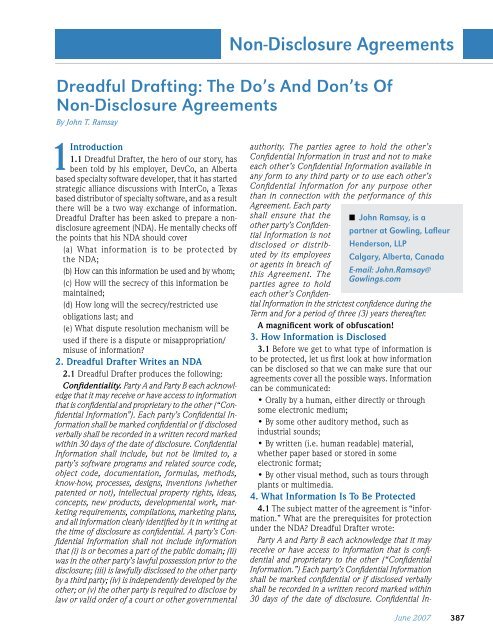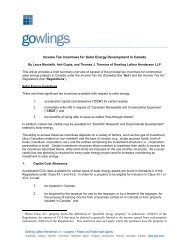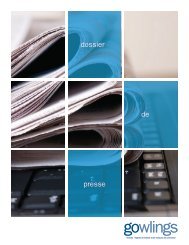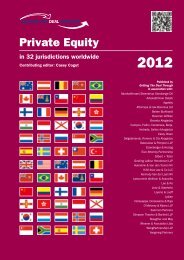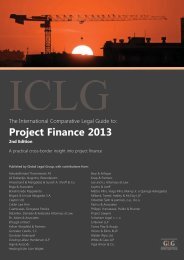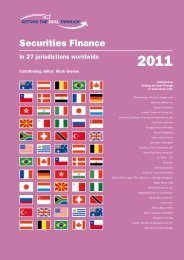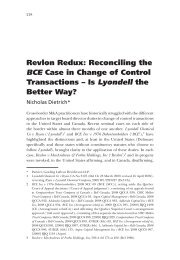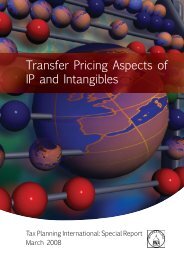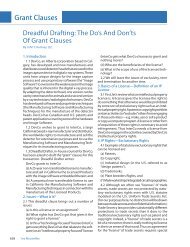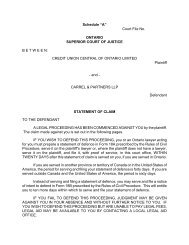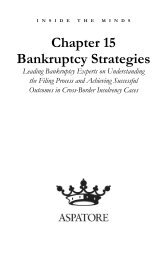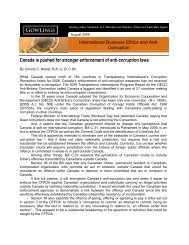Dreadful Drafting: The Do's and Don'ts of Non-Disclosure ... - Gowlings
Dreadful Drafting: The Do's and Don'ts of Non-Disclosure ... - Gowlings
Dreadful Drafting: The Do's and Don'ts of Non-Disclosure ... - Gowlings
You also want an ePaper? Increase the reach of your titles
YUMPU automatically turns print PDFs into web optimized ePapers that Google loves.
<strong>Non</strong>-<strong>Disclosure</strong> Agreements<br />
<strong>Dreadful</strong> <strong>Drafting</strong>: <strong>The</strong> Do’s And Don’ts Of<br />
<strong>Non</strong>-<strong>Disclosure</strong> Agreements<br />
By John T. Ramsay<br />
1<br />
Introduction<br />
1.1 <strong>Dreadful</strong> Drafter, the hero <strong>of</strong> our story, has<br />
been told by his employer, DevCo, an Alberta<br />
based specialty s<strong>of</strong>tware developer, that it has started<br />
strategic alliance discussions with InterCo, a Texas<br />
based distributor <strong>of</strong> specialty s<strong>of</strong>tware, <strong>and</strong> as a result<br />
there will be a two way exchange <strong>of</strong> information.<br />
<strong>Dreadful</strong> Drafter has been asked to prepare a nondisclosure<br />
agreement (NDA). He mentally checks <strong>of</strong>f<br />
the points that his NDA should cover<br />
(a) What information is to be protected by<br />
the NDA;<br />
(b) How can this information be used <strong>and</strong> by whom;<br />
(c) How will the secrecy <strong>of</strong> this information be<br />
maintained;<br />
(d) How long will the secrecy/restricted use<br />
obligations last; <strong>and</strong><br />
(e) What dispute resolution mechanism will be<br />
used if there is a dispute or misappropriation/<br />
misuse <strong>of</strong> information?<br />
2. <strong>Dreadful</strong> Drafter Writes an NDA<br />
2.1 <strong>Dreadful</strong> Drafter produces the following:<br />
Confidentiality. Party A <strong>and</strong> Party B each acknowledge<br />
that it may receive or have access to information<br />
that is confidential <strong>and</strong> proprietary to the other (“Confidential<br />
Information”). Each party’s Confidential Information<br />
shall be marked confidential or if disclosed<br />
verbally shall be recorded in a written record marked<br />
within 30 days <strong>of</strong> the date <strong>of</strong> disclosure. Confidential<br />
Information shall include, but not be limited to, a<br />
party’s s<strong>of</strong>tware programs <strong>and</strong> related source code,<br />
object code, documentation, formulas, methods,<br />
know-how, processes, designs, inventions (whether<br />
patented or not), intellectual property rights, ideas,<br />
concepts, new products, developmental work, marketing<br />
requirements, compilations, marketing plans,<br />
<strong>and</strong> all information clearly identified by it in writing at<br />
the time <strong>of</strong> disclosure as confidential. A party’s Confidential<br />
Information shall not include information<br />
that (i) is or becomes a part <strong>of</strong> the public domain; (ii)<br />
was in the other party’s lawful possession prior to the<br />
disclosure; (iii) is lawfully disclosed to the other party<br />
by a third party; (iv) is independently developed by the<br />
other; or (v) the other party is required to disclose by<br />
law or valid order <strong>of</strong> a court or other governmental<br />
authority. <strong>The</strong> parties agree to hold the other’s<br />
Confidential Information in trust <strong>and</strong> not to make<br />
each other’s Confidential Information available in<br />
any form to any third party or to use each other’s<br />
Confidential Information for any purpose other<br />
than in connection with the performance <strong>of</strong> this<br />
Agreement. Each party<br />
shall ensure that the ■ John Ramsay, is a<br />
other party’s Confidential<br />
Information is not<br />
partner at Gowling, Lafleur<br />
disclosed or distrib- Henderson, LLP<br />
uted by its employees Calgary, Alberta, Canada<br />
or agents in breach <strong>of</strong><br />
this Agreement. <strong>The</strong><br />
E-mail: John.Ramsay@<br />
<strong>Gowlings</strong>.com<br />
parties agree to hold<br />
each other’s Confidential<br />
Information in the strictest confidence during the<br />
Term <strong>and</strong> for a period <strong>of</strong> three (3) years thereafter.<br />
A magnificent work <strong>of</strong> obfuscation!<br />
3. How Information is Disclosed<br />
3.1 Before we get to what type <strong>of</strong> information is<br />
to be protected, let us first look at how information<br />
can be disclosed so that we can make sure that our<br />
agreements cover all the possible ways. Information<br />
can be communicated:<br />
• Orally by a human, either directly or through <br />
some electronic medium;<br />
• By some other auditory method, such as <br />
industrial sounds;<br />
• By written (i.e. human readable) material, <br />
whether paper based or stored in some <br />
electronic format;<br />
• By other visual method, such as tours through <br />
plants or multimedia.<br />
4. What Information Is To Be Protected<br />
4.1 <strong>The</strong> subject matter <strong>of</strong> the agreement is “information.”<br />
What are the prerequisites for protection<br />
under the NDA? <strong>Dreadful</strong> Drafter wrote:<br />
Party A <strong>and</strong> Party B each acknowledge that it may<br />
receive or have access to information that is confidential<br />
<strong>and</strong> proprietary to the other (“Confidential<br />
Information.”) Each party’s Confidential Information<br />
shall be marked confidential or if disclosed verbally<br />
shall be recorded in a written record marked within<br />
30 days <strong>of</strong> the date <strong>of</strong> disclosure. Confidential In-<br />
June 2007 387
<strong>Non</strong>-<strong>Disclosure</strong> Agreements<br />
formation shall include, but not be limited to, its<br />
s<strong>of</strong>tware programs <strong>and</strong> related source code, object<br />
code, documentation, formulas, methods, know-how,<br />
processes, designs, inventions (whether patented or<br />
not), intellectual property rights, ideas, concepts,<br />
new products, developmental work, marketing requirements,<br />
compilations, marketing plans, <strong>and</strong> all<br />
information clearly identified by it in writing at the<br />
time <strong>of</strong> disclosure as confidential.<br />
4.2 <strong>The</strong>re are essentially two models:<br />
(a) First, there is the narrow approach—the “trade<br />
secrecy model” where the information has to satisfy<br />
certain characteristics before it fits into the<br />
protected information category. This approach is<br />
most <strong>of</strong>ten used by the courts when deciding when<br />
there is an obligation <strong>of</strong> confidence <strong>and</strong> restricted<br />
use <strong>and</strong> there is no contract between the parties—sometimes<br />
referred to as a fiduciary duty <strong>of</strong><br />
confidence; <strong>and</strong><br />
(b) Secondly, there is the global approach—all information<br />
other than certain types <strong>of</strong> information that<br />
is excluded. This approach is the more traditional<br />
approach for contractual relationships.<br />
<strong>Dreadful</strong> Drafter used the “global approach” but<br />
he could draw from each approach as he draws the<br />
next drafts <strong>of</strong> his NDA.<br />
5. <strong>The</strong> Trade Secrecy Approach<br />
5.1 <strong>The</strong> trade secrecy approach protects far less<br />
information than the global approach. To qualify as a<br />
trade secret, the information usually has to have the<br />
following characteristics:<br />
(a) It is, or may be used in a trade or business;<br />
(b) It is not generally known in that trade <br />
or business;<br />
(c) It has economic value from not being generally<br />
known;<br />
(d) It is not readily ascertainable by proper means<br />
by other persons who can obtain economic value<br />
from its disclosure or use; <strong>and</strong><br />
(e) It is the subject <strong>of</strong> efforts that are reasonable<br />
under the circumstances to maintain its secrecy.<br />
5.2 <strong>Dreadful</strong> Drafter could note that absolute<br />
secrecy is not required—the requirement is only<br />
that the information cannot be “readily accessible.”<br />
Another characteristic is the requirement that the<br />
information has to be the ‘the subject <strong>of</strong> efforts that<br />
are reasonable under the circumstances to maintain<br />
its secrecy.” This characteristic rarely appears in<br />
NDAs that use the global approach. Why is there<br />
such a difference? Is the traditional practice wrong?<br />
<strong>Dreadful</strong> Drafter, when drawing agreements that are<br />
intended to protect his employer as the Recipient<br />
rather than the Disclosing Party, may want to adapt<br />
this concept into the global definition <strong>of</strong> Confidential<br />
Information.<br />
6. <strong>The</strong> Global Approach<br />
An example <strong>of</strong> a common global approach is:<br />
“Confidential Information” means all business <strong>and</strong><br />
technical information disclosed by one Party to the<br />
other Party.<br />
6.1 An example <strong>of</strong> a more detailed but still global<br />
approach is:<br />
“Confidential Information” means all technical<br />
data, s<strong>of</strong>tware, marketing information, customer<br />
lists, financial information <strong>and</strong> business plans, other<br />
information which relates to past, present, or future<br />
products, research <strong>and</strong> development, inventions,<br />
processes, or techniques <strong>of</strong> either party hereto.”<br />
7. <strong>Dreadful</strong> Drafter’s Approach<br />
7.1 Let’s look at <strong>Dreadful</strong> Drafter’s type <strong>of</strong><br />
definition. He wrote initially: “information that is<br />
confidential <strong>and</strong> proprietary to the other (“Confidential<br />
Information.”) That is a somewhat circular<br />
definition: Confidential Information is information<br />
that is confidential. Not very helpful. An examination<br />
would have to be done <strong>of</strong> each item <strong>of</strong> information<br />
to determine if it is <strong>of</strong> a confidential nature so that<br />
it qualifies for protection. By using the word “confidential”<br />
has he, inadvertently perhaps, adopted a<br />
“trade secrecy” approach?<br />
7.2 He also stated that the protected information<br />
has to be “proprietary.” This is a common buzz word<br />
for something that is “mine, mine, mine.” An online<br />
definition <strong>of</strong> the word is “[adj] protected by trademark<br />
or patent or copyright; made or produced or<br />
distributed by one having exclusive rights; ‘Tylenol’<br />
is a proprietary drug <strong>of</strong> which ‘acetaminophen’ is<br />
the generic form.” Other definitions refer to “title”<br />
or something that is “unique” to the entity that is<br />
claiming the proprietary right. But the case law in<br />
Canada <strong>and</strong> the U.S. seems to indicate that there is<br />
no “title” to information; information is not “property”<br />
although it gets “property-like” protection. If<br />
it is not property, can it be “proprietary?” <strong>Dreadful</strong><br />
Drafter might assist his clients by not using a word<br />
that does not have a clear legal meaning, even if<br />
it seems to have a comfortable, but unfortunately<br />
vague, business meaning.<br />
7.3 <strong>Dreadful</strong> Drafter added at the end <strong>of</strong> his<br />
definition <strong>of</strong> “Confidential Information” another<br />
qualifier for protection to his modified global definition:<br />
“clearly identified by it in writing at the time <strong>of</strong><br />
disclosure as confidential.” Information that is not<br />
388 les Nouvelles
<strong>Non</strong>-<strong>Disclosure</strong> Agreements<br />
so marked will not be protected. This will exclude<br />
information disclosed orally or by other auditory<br />
methods, <strong>and</strong> visual but non-textual methods (visual<br />
disclosures not capable <strong>of</strong> being marked, such as<br />
demonstrations, plant tours, etc.)<br />
7.4 Some examples <strong>of</strong> Confidential Information<br />
that may be used are:<br />
• formulae<br />
• algorithms<br />
• programs<br />
• products<br />
• composition<br />
• method<br />
• technique<br />
• process<br />
• information contained or embodied in a <br />
product device or mechanism <br />
• patent application(s)<br />
• Inventions not yet the subject <strong>of</strong> an issued <br />
patent or published patent application<br />
• pattern<br />
• plans<br />
• drawings<br />
• specifications<br />
• device<br />
• prototypes<br />
• samples<br />
• demonstrations<br />
• scientific <strong>and</strong> technical information<br />
• photographs<br />
• s<strong>of</strong>tware programs<br />
• business policies<br />
• business practices<br />
• financial data<br />
• economic data<br />
• economic evaluations<br />
• economic models<br />
• business information<br />
• personally identifiable information about individuals<br />
in the organization, applicants for positions<br />
within the organization, or about other persons<br />
whom the company would someday like to have<br />
as a part <strong>of</strong> their organization.<br />
• competitive intelligence data<br />
• information about those with whom the<br />
company interacts, whether its own employees,<br />
a customer or potential customer, an investor, a<br />
joint venturer or a supplier<br />
• information received from others that the<br />
Disclosing Party is obliged to keep confidential<br />
7.5 Business information can include positive information<br />
(e.g. which are the best selling products<br />
in your line) <strong>and</strong> negative information (e.g. which<br />
products have the smallest pr<strong>of</strong>it margin). Trade<br />
secrets need not arise only from the company’s<br />
commercial triumphs. Trade secrets can arise out<br />
<strong>of</strong> unsuccessful efforts <strong>of</strong> the company in the past<br />
such as research <strong>and</strong> development studies that<br />
led to dead ends, failed or inconclusive efforts<br />
<strong>of</strong> the company (including ongoing cutting edge<br />
research, <strong>and</strong> something that has not yet happened<br />
such as future plans for product introduction or<br />
market expansion).<br />
8. <strong>Dreadful</strong> Drafter’s List<br />
8.1 <strong>Dreadful</strong> Drafter’s list was very concise. He<br />
wrote:<br />
“s<strong>of</strong>tware programs <strong>and</strong> related source code,<br />
object code, documentation, formulas, methods,<br />
know-how, processes, designs, inventions<br />
(whether patented or not), intellectual property<br />
rights, ideas, concepts, new products, developmental<br />
work, marketing requirements, marketing<br />
plans.” (Underlining added for emphasis.)<br />
8.2 <strong>The</strong> word “related” causes a problem—does<br />
every type <strong>of</strong> Confidential Information that follows<br />
have to “relate” to the s<strong>of</strong>tware programs? Where<br />
does the modification stop?<br />
8.3 He included “know-how.” When is know-how<br />
worthy <strong>of</strong> protection <strong>and</strong> when is it merely pr<strong>of</strong>essional<br />
expertise? If an individual has been hired for<br />
his expertise, he will resist signing any document<br />
that will restrict his continued use <strong>of</strong> that expertise<br />
elsewhere. Should the list only include embodiments<br />
<strong>of</strong> knowledge or should it include the knowledge<br />
itself? We will discuss this point further when we get<br />
to the concept <strong>of</strong> “Residuals.” Since know-how is not<br />
codified, it will be difficult to determine when it is<br />
disclosed <strong>and</strong> what is this “know-how” information<br />
that is to be protected.<br />
8.4 <strong>Dreadful</strong> Drafter included the word “inventions”<br />
in his list. “Inventions,” when used in the<br />
Patent Act, has a very specific meaning. Does it<br />
have the same meaning here? Why should Confidential<br />
Information include “inventions” that are<br />
the subject matter <strong>of</strong> issued patents or published<br />
patent applications? That information is in the public<br />
domain once the patent is published or issued. If the<br />
normal carve-out exceptions (discussed below) are<br />
used, the published or patented inventions could<br />
be automatically excluded <strong>and</strong> no harm is done.<br />
Otherwise that definition is too extensive <strong>and</strong> may<br />
cause the Recipient to hold secret <strong>and</strong> be restricted<br />
June 2007 389
<strong>Non</strong>-<strong>Disclosure</strong> Agreements<br />
in using information that others can freely obtain<br />
from the public domain.<br />
8.5 <strong>Dreadful</strong> Drafter included “intellectual property<br />
rights.” But “rights” are not “information.” <strong>The</strong><br />
intellectual property itself may be “information”<br />
but the rights are not. When <strong>Dreadful</strong> Drafter is<br />
trying to define one type <strong>of</strong> intellectual property,<br />
namely Confidential Information, it may be circular<br />
to even include the intellectual property itself.<br />
Many drafters are <strong>of</strong> the position that “Confidential<br />
Information” or “trade secrets” are not intellectual<br />
property <strong>and</strong> that phrase should be restricted to<br />
rights that are granted by federal statute (patents,<br />
copyright, integrated circuit topographies, plants,<br />
industrial designs, trademarks, etc). It might be<br />
better if <strong>Dreadful</strong> Drafter did not use either “intellectual<br />
property” or “intellectual property rights” in<br />
his list <strong>of</strong> examples.<br />
8.6 “Ideas” that are not reduced to practice may<br />
have a scope that is also far too broad. How will<br />
the Recipient ever know when it has contravened<br />
the obligation to keep secret <strong>and</strong> use for restricted<br />
purposes this “idea”? This may not even be at the<br />
knowledge stage.<br />
8.7 “Concepts” may be a little further down the<br />
development stage than “ideas” but unless they are<br />
fixed in some manner they also should not be subject<br />
to protection due to the vagueness <strong>of</strong> what could<br />
be covered. This is an example <strong>of</strong> the merit <strong>of</strong> using<br />
trade secrecy as a requirement for protection. Remember<br />
the requirement that the secret have value<br />
to deserve. Ideas <strong>and</strong> concepts, although sometimes<br />
the most creative, are usually the least valuable.<br />
8.8 <strong>The</strong> word “new” as the modifier to “products”<br />
will likely be a source <strong>of</strong> controversy—what essential<br />
feature will be required so that the product<br />
is “new” rather than just an improvement over an<br />
“old” product.<br />
8.9 Otherwise his list may be acceptable so long<br />
as he examined the list for application to his specific<br />
purposes. A one-size list for all purposes may<br />
not be the best plan. Should <strong>Dreadful</strong> Drafter use<br />
them all or should he tailor his list for the particular<br />
facts? <strong>The</strong>re is no easy answer for this. <strong>The</strong> main<br />
advantage <strong>of</strong> listing particular examples is the assistance<br />
it provides to the parties as to what they<br />
were in fact talking about when they entered into<br />
the agreement.<br />
8.10 If the Permitted Purposes are narrow in scope<br />
<strong>and</strong> the technology is well defined, a specific description<br />
tailored for the particular purposes may be appropriate.<br />
Often the description can be attached as<br />
a schedule. However, <strong>Dreadful</strong> Drafter better make<br />
sure that the schedule is actually attached to avoid<br />
his president’s wrath later when misappropriation is<br />
being examined <strong>and</strong> the parties find that no schedule<br />
was attached. Also <strong>Dreadful</strong> Drafter should examine<br />
the schedule to make sure that it:<br />
(a) is not so specific that the secrets themselves<br />
are disclosed by the schedule—the agreement<br />
itself is <strong>of</strong>ten not treated as confidential at all or<br />
if agreed to be confidential not treated with the<br />
same care as the disclosed information; <strong>and</strong><br />
(b) does not use definitions inconsistent with<br />
the main agreement.<br />
9. Carve Outs<br />
9.1 <strong>Dreadful</strong> Drafter <strong>of</strong>fered these carve outs:<br />
A party’s Confidential Information shall not include<br />
information that (i) is or becomes a part <strong>of</strong><br />
the public domain; (ii) was in the other party’s<br />
lawful possession prior to the disclosure; (iii) is<br />
lawfully disclosed to the other party by a third<br />
party; (iv) is independently developed by the other<br />
party; or (v) the other party is required by law<br />
or valid order <strong>of</strong> a court or other governmental<br />
authority to disclose.<br />
9.2 Let us break each <strong>of</strong> these exceptions or carveouts<br />
into their component parts.<br />
10. Public Domain<br />
10.1 <strong>Dreadful</strong> Drafter does not give much direction<br />
as to the timing <strong>of</strong> the entry to the public domain.<br />
Does “is,” in the phrase “is or becomes a part <strong>of</strong> the<br />
public domain,” refer to the date <strong>of</strong> the execution<br />
<strong>of</strong> the agreement or the date <strong>of</strong> the disclosure? How<br />
about disclosures that result from the failure <strong>of</strong> the<br />
Recipient to comply with the agreement? <strong>Dreadful</strong><br />
Drafter correctly anticipated that Confidential Information<br />
could enter the public domain after the<br />
disclosure, but he could have limited his language<br />
a bit. <strong>Dreadful</strong> Drafter could consider: “information<br />
that is in the public domain at the date <strong>of</strong> the<br />
disclosure or thereafter enters the public domain<br />
(but this exception applies only after the release <strong>of</strong><br />
the information into the public domain) without the<br />
Recipient’s breach <strong>of</strong> any obligation to the Disclosing<br />
Party.”<br />
10.2 But what is the “public domain”? A substitute<br />
phrase may be “publicly available” but neither really<br />
help. Does an obscure publication qualify? How about<br />
an unrecorded speech? Is this equivalent to “prior<br />
art” in the patent world? Some agreements define<br />
public domain or publicly available. Consider:<br />
<strong>The</strong> phrase “publicly known” means readily accessible<br />
to the public in a written publication, <strong>and</strong> shall<br />
390 les Nouvelles
<strong>Non</strong>-<strong>Disclosure</strong> Agreements<br />
not include information which is only available by<br />
substantial searching <strong>of</strong> the published literature <strong>and</strong><br />
information, the substance <strong>of</strong> which must be pieced<br />
together from a number <strong>of</strong> different publications<br />
<strong>and</strong> sources.<br />
11. Blended Information<br />
11.1 If only individual parts <strong>of</strong> the information are<br />
in the public domain but not the compilation itself,<br />
then the compilation may have value that is worthy<br />
<strong>of</strong> protection under the NDA. It is a principle <strong>of</strong><br />
common law in Canada that when the information<br />
is blended, partly public <strong>and</strong> partly private, then the<br />
recipient must take special care to use only the material<br />
in the public domain. He should go to a public<br />
source to get it. He should not get a head start over<br />
others by using the information which he received<br />
in confidence. Thus the combination itself should<br />
be singled out for protection—it is an exception<br />
to the excepted public domain information. <strong>Dreadful</strong><br />
Drafter had included in his list <strong>of</strong> examples <strong>of</strong><br />
Confidential Information “compilations.” It might<br />
be better to address the concept by a specific clause<br />
so that the reader underst<strong>and</strong>s the importance <strong>of</strong><br />
compilations.<br />
11.2 Consider adding at the end <strong>of</strong> the definition:<br />
Confidential Information shall not be deemed<br />
to be information in the public domain merely<br />
because any part <strong>of</strong> such information includes<br />
individual features, components or combinations<br />
that are now or become known to the public.<br />
12. Who Leaked the Information Into the<br />
Public Domain?<br />
12.1 <strong>Dreadful</strong> Drafter did not consider the possibility<br />
that the information entered the public domain<br />
as a result <strong>of</strong> a failure <strong>of</strong> the Recipient. Although that<br />
might be considered to be a violation <strong>of</strong> the agreement<br />
<strong>and</strong> therefore surely the Recipient cannot rely<br />
on its own breach to carve-out information from the<br />
scope <strong>of</strong> Confidential Information, many NDAs add<br />
a restriction such as:<br />
Confidential Information does not include<br />
information that is or comes into the public<br />
domain otherwise than by disclosure or default<br />
by the Recipient.<br />
12.2 Does that forgive a breach that occurred<br />
before the information entered the public domain?<br />
Some agreements go one step further like this:<br />
Confidential Information does not include information<br />
that is or becomes generally available in the<br />
public domain through no fault <strong>of</strong> the Recipient<br />
(but only after it so becomes generally available).<br />
13. Residuals<br />
13.1 <strong>Dreadful</strong> Drafter did not contemplate the<br />
very significant issue <strong>of</strong> enhanced pr<strong>of</strong>essional<br />
skills or experience as a result <strong>of</strong> an individual being<br />
exposed to the Confidential Information. How can<br />
she remove this knowledge, particularly knowledge<br />
<strong>of</strong> general application, from her brain? <strong>The</strong>re seems<br />
to be two ways <strong>of</strong> trying to deal with this issue.<br />
First, there has developed the concept <strong>of</strong> “residuals.”<br />
Second there is an approach more focused on<br />
“enhanced pr<strong>of</strong>essional expertise.” Is there really<br />
any difference?<br />
13.2 Let us first look at Residuals. Daniel B. Hassett<br />
writes in his article: “Is Your Model <strong>Non</strong>-<strong>Disclosure</strong><br />
Agreement Adequate?” April 2003: 1<br />
Upon termination <strong>of</strong> an NDA, some NDAs allow<br />
the Recipient’s employees to retain <strong>and</strong> use, in<br />
future products <strong>and</strong> services, all information in<br />
their head obtained from reviewing confidential<br />
information without restriction under the NDA.<br />
This sometimes is called “residuals.” Depending<br />
upon the type <strong>and</strong> sensitivity <strong>of</strong> the information<br />
disclosed, the ability to use “residuals” may render<br />
the NDA meaningless.<br />
13.3 <strong>Dreadful</strong> Drafter makes this attempt at a<br />
residuals clause.<br />
“Confidential Information shall not include<br />
Residuals where “Residuals” means any idea,<br />
concept, know-how <strong>and</strong> other information that<br />
is derived from <strong>of</strong> the Disclosing Party <strong>and</strong> retained<br />
in the unaided memories <strong>of</strong> employees<br />
who have had rightful access to the Disclosing<br />
Party’s Confidential Information in accordance<br />
with this Agreement.<br />
13.4 This is a controversial provision. Some may<br />
say that this clause really favours the individual with<br />
a good or photographic memory. <strong>The</strong> controversy<br />
around Residuals results from this emphasis on what<br />
can be retained in memory rather than an emphasis<br />
on the nature <strong>of</strong> the information that is remembered.<br />
Care must be used to draft a clear distinction between<br />
enhanced pr<strong>of</strong>essional expertise that results<br />
from the information retained in memory <strong>and</strong> trade<br />
secrets that are retained in memory. Some would<br />
argue that lots <strong>of</strong> remembered information could be<br />
considered to be trade secrets; only some qualify as<br />
enhanced knowledge that, if it could not be used the<br />
individual, he could not continue to be mobile <strong>and</strong> his<br />
employment opportunities thus would be restricted.<br />
1. www.wrf.com/publication.cfm?publication_id=10040<br />
June 2007 391
<strong>Non</strong>-<strong>Disclosure</strong> Agreements<br />
An NDA should not inadvertently convert itself into<br />
a non-compete agreement.<br />
13.5 Should Residuals be an exception from<br />
Confidential Information or a permitted use <strong>of</strong><br />
Confidential Information? If it is not Confidential<br />
Information to start with, it will not be covered by<br />
the NDA. <strong>Dreadful</strong> Drafter tries this residuals clause<br />
on for size:<br />
<strong>The</strong> Recipient shall be free to use for any purpose<br />
the Residuals gained from access to or work with<br />
the Confidential Information <strong>of</strong> the Disclosing<br />
Party, provided that the Recipient shall not<br />
disclose the Confidential Information except as<br />
expressly permitted pursuant to the terms <strong>of</strong> this<br />
Agreement. <strong>The</strong> term “Residuals” means information<br />
in intangible form, which is inadvertently<br />
retained in memory by persons who have had<br />
access to the Confidential Information, including<br />
ideas, concepts, know-how or techniques<br />
contained therein. <strong>The</strong> Recipient shall not have<br />
any obligation to limit or restrict the assignment<br />
<strong>of</strong> such persons or to pay royalties for any work<br />
resulting from the use <strong>of</strong> Residuals. However, this<br />
subparagraph shall not be deemed to grant to the<br />
Recipient a license under the Disclosing party’s<br />
copyrights or patents.<br />
13.6 This residual clause has some odd provisions:<br />
(a) Is it the Recipient that is entitled to use the<br />
Residuals, or only the individual that gained<br />
the knowledge? Are we talking about corporate<br />
memory or individual human memory? To overcome<br />
this error some agreements refer to employees<br />
<strong>of</strong> the Recipient but may have excluded<br />
the employee-like contractors that have become<br />
the vogue in our cost-cutting environments<br />
where we do not want to pay benefits, etc.<br />
(b) <strong>The</strong> information has to be in intangible form.<br />
All information is intangible; it can be stored or<br />
displayed in tangible form or stored or displayed<br />
intangibly in some manner, including stored in<br />
the human memory. <strong>Dreadful</strong> Drafter is really<br />
trying to focus on the idea that the memory-hog<br />
individual cannot rely on anything tangible to<br />
prompt her memory; she cannot use any assists.<br />
But <strong>Dreadful</strong> Drafter may have inadvertently<br />
deleted from the permitted “Residuals use”<br />
all information that was disclosed to “Memory<br />
Hog” in tangible form.<br />
(c) <strong>The</strong> retention in memory has to be “inadvertent.”<br />
As a result there will now be a triable issue<br />
as to whether Memory Hog tried to remember<br />
the information or the memory just happened.<br />
Hard on those <strong>of</strong> us who seem a bit thicker in<br />
the head <strong>and</strong> can only improve our pr<strong>of</strong>essional<br />
expertise by trying! <strong>The</strong> clinical psychologist<br />
could have lots <strong>of</strong> fun with this issue.<br />
(d) Note that <strong>Dreadful</strong> Drafter added a list <strong>of</strong><br />
examples <strong>of</strong> Confidential Information – “Confidential<br />
Information, including ideas, concepts,<br />
know-how or techniques contained therein.”<br />
Ideas <strong>and</strong> concepts are really abstract <strong>and</strong> you<br />
can see why <strong>Dreadful</strong> Drafter may be tempted to<br />
include them in Residuals. But Confidential Information<br />
was already defined <strong>and</strong> now we have<br />
another definition. Was <strong>Dreadful</strong> Drafter trying<br />
in some clumsy manner to get to enhanced pr<strong>of</strong>essional<br />
expertise <strong>and</strong> legitimate trade secrets<br />
worthy <strong>of</strong> protection?<br />
(e) <strong>Dreadful</strong> Drafter added the proviso: “free<br />
to use the Residuals, but shall not disclose the<br />
Confidential Information except as expressly permitted<br />
pursuant to the terms <strong>of</strong> this Agreement.”<br />
But as designed here, aren’t Residuals a subset<br />
<strong>of</strong> Confidential Information? Has a bad concept<br />
become worse by trying to deal with worries about<br />
Memory Hogs?<br />
(f) Even though <strong>Dreadful</strong> Drafter had said in the<br />
first sentence that the Recipient was free to use<br />
the Residuals, he felt it necessary to say that the<br />
Recipient could assign the Residuals <strong>and</strong> did not<br />
have to pay royalties. This sounds more <strong>and</strong> more<br />
like proprietary information <strong>and</strong> less <strong>and</strong> less like<br />
enhanced pr<strong>of</strong>essional expertise. If this information<br />
is so generic that it can be freely used by<br />
the individual, why are we so concerned about it<br />
being assignable <strong>and</strong> royalty free? This concern<br />
over Residuals being something more that reusable<br />
information is reinforced by the reference<br />
in the last sentence about the Disclosing Party’s<br />
copyrights or patents. Are we in some patchwork<br />
fashion eroding the desired goal – the continued<br />
use <strong>of</strong> enhanced pr<strong>of</strong>essional expertise?<br />
13.7 Perhaps <strong>Dreadful</strong> Drafter would want to prohibit<br />
Memory Hog from revealing where he sourced<br />
a Residual—that in itself could be Confidential Information,<br />
the revelation <strong>of</strong> which could harm the<br />
Disclosing Party.<br />
13.8 Could <strong>Dreadful</strong> Drafter address the enhanced<br />
pr<strong>of</strong>essional expertise issue directly? Consider:<br />
“Confidential Information” shall not include the<br />
general skills <strong>and</strong> experience gained during Consultant’s<br />
work with the Disclosing Company that<br />
could reasonably have been expected to acquire<br />
in similar work with another company.<br />
14. Prior Possession<br />
14.1 <strong>Dreadful</strong> Drafter’s second carve-out was:<br />
392 les Nouvelles
<strong>Non</strong>-<strong>Disclosure</strong> Agreements<br />
A party’s Confidential Information shall not include<br />
information that (ii) was in the other party’s lawful<br />
possession prior to the disclosure.<br />
14.2 “Possession” may be an unfortunate term if<br />
we concede that information cannot be owned <strong>and</strong><br />
therefore not “possessed.” Would <strong>Dreadful</strong> Drafter<br />
be better <strong>of</strong>f using “known”? But, how will we<br />
know if the Recipient had that knowledge. Some<br />
agreements require the Recipient to show by written<br />
document that it had this knowledge (for once<br />
“possession” makes sense—it has to possess a record<br />
<strong>of</strong> the information). Consider:<br />
Confidential Information shall not include information<br />
that was already known to the Recipient<br />
as evidenced by written record pre-dating such<br />
disclosure.<br />
14.3 Some agreements are not so focused on the<br />
type <strong>of</strong> pro<strong>of</strong>. Consider:<br />
Confidential Information shall not include information<br />
that the Recipient can prove was known<br />
to it at the time <strong>of</strong> disclosure by the Disclosing<br />
Party<br />
14.4 Some even more cautious (although not necessarily<br />
more practical) drafters require the Recipient<br />
to acknowledge within 30 days that it already has<br />
the information. Try to put that one into practice!<br />
Consider:<br />
For the Recipient to rely on this exception, it must<br />
give notice within 30 days <strong>of</strong> the disclosure <strong>of</strong> the<br />
subject information within 30 days <strong>of</strong> the date <strong>of</strong><br />
its disclosure.<br />
14.5 Will this cause the Recipient problems if the<br />
mere knowledge <strong>of</strong> that information was something<br />
it was keeping secret?<br />
14.6 In some cases, the NDA may relate to the<br />
disclosure <strong>of</strong> a physical item. Since information is<br />
more abstract, some drafters like to catch the concrete<br />
item that was disclosed. Consider:<br />
Confidential Information does not include an [innovation]<br />
that was independently developed or<br />
derived by the Recipient prior to the disclosure.<br />
15. Learned From Someone Else<br />
15.1 Even though the Recipient did not previously<br />
know the disclosed information <strong>and</strong> it is not in the<br />
public domain, there is the possibility that some<br />
one else discloses this information to the Recipient.<br />
When that someone has the knowledge <strong>and</strong> is telling<br />
others about it, the Recipient will not want to<br />
continue to be bound by its obligations <strong>of</strong> secrecy<br />
<strong>and</strong> restricted use. A common carve-out is:<br />
Confidential Information shall not include information<br />
that was or is lawfully obtained or available<br />
from a third party who was lawfully in possession<br />
<strong>of</strong> the same <strong>and</strong> free to disclose it.<br />
15.2 That’s nice, but how does Recipient know<br />
whether the third party “possessed” this information<br />
lawfully or was free to disclose it. Surely we<br />
want to restrict this condition to leakages that the<br />
Recipient participated in or at least condoned. <strong>The</strong>re<br />
are many ways that a Recipient can participate in<br />
the misappropriation <strong>of</strong> Confidential Information.<br />
Consider these (adapted from the U.S. Uniform<br />
Trade Secrets Act):<br />
(a) acquisition <strong>of</strong> a trade secret <strong>of</strong> another by a<br />
person who knows or has reason to know that the<br />
trade secret was acquired by improper means<br />
(b) at the time <strong>of</strong> disclosure or use knew or had<br />
reason to know that his knowledge <strong>of</strong> the trade<br />
secret was<br />
(i) derived from or through a person who has<br />
utilized improper means to acquire it;<br />
(ii) acquired under circumstances giving rise<br />
to a duty to maintain its secrecy or limit its<br />
use; or<br />
(iii) derived from or through a person who<br />
owed a duty to the person seeking relief to<br />
maintain its secrecy or limit its use;<br />
(c) the Recipient knew or had reason to know<br />
that it was a trade secret <strong>and</strong> that knowledge <strong>of</strong><br />
it had been acquired by accident or mistake.<br />
15.3 Consider:<br />
Confidential Information does not include information<br />
that is or becomes available on a nonconfidential<br />
basis from an independent third party<br />
who, to the Recipient’s knowledge, was not under<br />
a duty <strong>of</strong> confidence to the Disclosing Party (but<br />
only after it becomes so available);<br />
16. Court Actions<br />
16.1 <strong>Dreadful</strong> Drafter’s definition <strong>of</strong> Confidential<br />
Information had as the third exception: “A party’s<br />
Confidential Information shall not include information<br />
that (v) the other party is required to disclose by<br />
law or valid order <strong>of</strong> a court or other governmental<br />
authority.”<br />
16.2 <strong>Dreadful</strong> Drafter may have failed to contemplate<br />
court actions <strong>and</strong> disclosures to governmental<br />
agencies where the information remained under<br />
continued confidentiality. A disclosure <strong>of</strong> this type<br />
should not relieve the Recipient <strong>of</strong> other obligations<br />
<strong>of</strong> secrecy <strong>and</strong> continued use; this should only<br />
happen when the information enters the public<br />
domain. It might be better to provide that if the<br />
June 2007 393
<strong>Non</strong>-<strong>Disclosure</strong> Agreements<br />
court or governmental required disclosure, this be<br />
expressly permitted perhaps with provisions about<br />
the efforts needed to oppose the disclosure <strong>and</strong><br />
notice to the Disclosing Party so it can intervene<br />
in the action itself.<br />
16.3 Consider<br />
If the Recipient is required to disclose all or any<br />
part <strong>of</strong> the Confidential Information to any court,<br />
tribunal or government authority<br />
i) if legally permitted to do so, it shall as soon<br />
as possible give written notice <strong>of</strong> such requirement<br />
to the Disclosing Party requirement, <strong>and</strong><br />
all relevant particulars there<strong>of</strong>, to allow the<br />
Disclosing Party a reasonable opportunity to<br />
seek protective order or equivalent; <strong>and</strong><br />
ii) it shall make a reasonable effort to obtain a<br />
protective order requiring that the Confidential<br />
Information so disclosed be kept secret by<br />
protective measures appropriate for the sensitivity<br />
<strong>of</strong> the subject information <strong>and</strong> that the<br />
Confidential Information be used only for the<br />
purposes for which the order was issued.<br />
If such disclosure is obliged, then it shall not be<br />
deemed to be a breach <strong>of</strong> the Recipient’s obligations<br />
under this Agreement.<br />
17. Obligation to Provide Complete <strong>and</strong><br />
Accurate Information<br />
17.1 Although most NDAs only cover obligations<br />
<strong>of</strong> confidentiality <strong>and</strong> restrictions on permitted use,<br />
some NDAs go further <strong>and</strong> impose an obligation to<br />
disclose complete <strong>and</strong> accurate information.<br />
17.2 Consider:<br />
(i) <strong>The</strong> Disclosing Party shall provide the Recipient<br />
with all information in the possession <strong>of</strong> the<br />
Disclosing Party reasonably necessary for the<br />
Recipient to assess the merits <strong>of</strong> establishing the<br />
Strategic Alliance.<br />
(ii) <strong>The</strong> Disclosing Party warrants that the<br />
information disclosed to the Recipient will be<br />
accurate.<br />
18. Completeness<br />
18.1 Most parties will resist a warranty <strong>of</strong> completeness<br />
even in a negotiated definitive agreement<br />
executed after considerable due diligence has been<br />
performed. Even after all that due diligence, a prudent<br />
warranting party will be insecure that some<br />
information will have been omitted—particular if<br />
trade secrets or any know-how are involved. Many<br />
companies do not have an accurate inventory <strong>of</strong> their<br />
patents <strong>and</strong> trademarks, let alone an inventory <strong>of</strong><br />
key trade secrets or a codification <strong>of</strong> know-how.<br />
Thus, the warranty <strong>of</strong> completeness, by its nature,<br />
must be restricted to a very focused <strong>and</strong> precise<br />
sector <strong>of</strong> information. It is not appropriate in an<br />
NDA that has a broad, sweeping definition <strong>of</strong> protected<br />
information. It is not a matter <strong>of</strong> fairness<br />
nor favouritism between the parties; it is a matter<br />
<strong>of</strong> being a virtual impossibility.<br />
19. Accuracy<br />
19.1 In the early stages <strong>of</strong> exploring the potential<br />
for a strategic alliance, there is likely to be an<br />
exchange <strong>of</strong> private <strong>and</strong> public information. Again,<br />
since the information will not have been subjected<br />
to disciplined due diligence <strong>and</strong> since the free-flow <strong>of</strong><br />
information is likely to be preferred over the requirement<br />
for absolute accuracy, it is to be expected that<br />
inaccurate information will be exchanged. A more<br />
appropriate warranty may be that the Disclosing<br />
Party will not disclose any information that it knows<br />
to be untrue or that is intended to deceive. In any<br />
event, the Disclosing Party is not likely to be able<br />
to determine the accuracy <strong>of</strong> the public information<br />
it passes on. It might be able to warrant, however,<br />
that it has not knowingly introduced inaccuracies<br />
into that public information.<br />
20. Personally Identifiable Information<br />
20.1 If the information that is intended to be<br />
exchanged includes personally identifiable information,<br />
then a review <strong>of</strong> the applicable privacy laws<br />
will be necessary. Privacy laws generally cover the<br />
collection (including the consent to collection), use,<br />
disclosure <strong>and</strong> efforts to maintain the secrecy <strong>of</strong><br />
personally identifiable information. Such information<br />
can only be used for the purposes for which it was<br />
collected <strong>and</strong> these are unlikely to cover the majority<br />
<strong>of</strong> reasons for entering into an NDA.<br />
20.2 Even if the transfer <strong>of</strong> the personally identified<br />
information is permitted, the parties must address<br />
the possibility <strong>of</strong> an individual dem<strong>and</strong>ing from<br />
the Recipient details <strong>of</strong> what information the Recipient<br />
has, how that information has been protected<br />
<strong>and</strong> who has accessed it. Such a disclosure should<br />
be considered to be a permitted use, (along with<br />
disclosure through a court or other governmental<br />
inquiry), if applicable privacy laws apply. This issue<br />
becomes complex due to the fundamental different<br />
privacy laws that exist from jurisdiction to jurisdiction<br />
(<strong>and</strong> even within Canada, provincial laws that<br />
conflict with each other as well as with the federal<br />
legislation).<br />
21. “Feedback” Exception<br />
21.1 Consider a bilateral NDA where the<br />
Recipient <strong>of</strong>fers suggestions to improve the value<br />
<strong>of</strong> the information disclosed by the Disclosing Party.<br />
394 les Nouvelles
<strong>Non</strong>-<strong>Disclosure</strong> Agreements<br />
Can the Disclosing Party freely use that information?<br />
<strong>Dreadful</strong> Drafter’s NDA (like most NDAs) does not<br />
cover this situation. However, there may be a contractual<br />
covenant to keep the feedback confidential, or a<br />
court might find an obligation <strong>of</strong> confidence, finding<br />
a fiduciary or equitable obligation if the parties were<br />
in discussion about a partnership or strategic alliance<br />
<strong>of</strong> some sort. Many Disclosing Parties will find<br />
that result objectionable <strong>and</strong> may want to carve-out<br />
what is <strong>of</strong>ten called “feedback” information from the<br />
information that is to be kept confidential. Hassett<br />
(See citation in Section 13.2 <strong>of</strong> this Article) <strong>of</strong>fers<br />
the following comment:<br />
An NDA may also carve-out from the definition <strong>of</strong><br />
confidential information suggestions, comments<br />
or other “feedback” supplied by the Recipient to<br />
the disclosing party. <strong>The</strong> Recipient may be able<br />
to make future use <strong>of</strong> the suggestions or other<br />
feedback without any restrictions or license fees<br />
owed to the disclosing party—even if the Recipient<br />
was not aware <strong>of</strong> a particular idea or concept<br />
except through its review <strong>of</strong> the disclosing party’s<br />
confidential information.<br />
21.2 A “feedback” carve-out may look like this:<br />
Confidential Information shall not include<br />
information that constitutes Feedback, where<br />
“Feedback” is defined as suggestions, comments,<br />
or other feedback to the Disclosing Party with respect<br />
to Confidential Information provided originally<br />
by the Disclosing Party. It is acknowledged<br />
that the Recipient may from time to time provide<br />
Feedback, <strong>and</strong> it is agreed that all Feedback is<br />
provided entirely voluntarily. Feedback, even if<br />
designated as confidential by the party <strong>of</strong>fering<br />
the Feedback, shall not, absent a separate written<br />
agreement, create any confidentiality obligation<br />
for the recipient <strong>of</strong> the Feedback. Subject to any<br />
separate agreement between the parties, the recipient<br />
<strong>of</strong> Feedback shall be free to use, disclose,<br />
reproduce, license or otherwise distribute, <strong>and</strong><br />
exploit the Feedback as it sees fit, entirely without<br />
obligation or restriction <strong>of</strong> any kind on account <strong>of</strong><br />
intellectual property rights or otherwise.<br />
21.3 Some even more cautious writers might add:<br />
<strong>The</strong> provider <strong>of</strong> Feedback shall not give Feedback<br />
that is subject to any license terms that seek to<br />
require the other party to obtain a license to use<br />
that Feedback.<br />
21.4 Can you imagine how Feedback clauses will<br />
encourage the free discussion <strong>of</strong> disclosed confidential<br />
information! Each party will try to encourage the<br />
other to provide Feedback but in turn have nothing<br />
to say about what it has learned. Consider the dampening<br />
effect this might have on any attempt to have<br />
an open collaboration. Also consider what happens<br />
when the Disclosing Party provides Feedback to the<br />
Recipient’s Feedback. Oh, it warms the litigator’s<br />
heart to see such complexity!<br />
22. Onus <strong>of</strong> Pro<strong>of</strong><br />
22.1 Hassett writes:<br />
Most NDAs contain carve-outs or exclusions from <br />
the definition <strong>of</strong> “Confidential Information.” <br />
<strong>The</strong>se exclusions present evidentiary problems <br />
for both parties, <strong>and</strong> their use should be carefully <br />
considered (e.g., can the Recipient prove that <br />
it independently developed an invention if the <br />
disclosed confidential information was generally <br />
available to all <strong>of</strong> the Recipient’s employees?). <br />
22.2 Consider adding before the list <strong>of</strong> carve-outs:<br />
“but Confidential Information shall not include <br />
information that the Recipient can establish (insert <br />
list <strong>of</strong> carve-outs).” OR<br />
“<strong>The</strong> onus <strong>of</strong> pro<strong>of</strong> that information fits within one <br />
<strong>of</strong> the exceptions shall be on the Recipient.” <br />
23. Requirement To Mark “Confidential”<br />
23.1 <strong>Dreadful</strong> Drafter wrote: “Each party’s Confidential<br />
Information be marked confidential or if disclosed<br />
verbally shall be recorded in a written record<br />
marked within 30 days <strong>of</strong> the date <strong>of</strong> disclosure.”<br />
23.2 This will greatly assist in a dispute where<br />
the parties are trying to recall what was disclosed<br />
by whom when. Lawyers like it; but is it practical?<br />
Will it be abused—will everything be marked “Confidential”?<br />
Will information not qualify for protection<br />
when not marked even though any reasonable person<br />
would have recognised it as confidential? <strong>The</strong>re is<br />
no easy answer. If the relationship will involve the<br />
disclosure <strong>of</strong> very specific information, then the<br />
marking is appropriate. If there is to be a free exchange<br />
<strong>of</strong> ideas, the marking requirement becomes<br />
more <strong>of</strong> a problem. Some drafters are worried that<br />
the word “confidential” is too confining <strong>and</strong> information<br />
marked “secret” will be not be included in the<br />
carve out. Consider:<br />
Confidential Information will also not include <br />
information that is in physical form <strong>and</strong> is not <br />
marked “Confidential” or otherwise marked in <br />
such a manner that would cause a reasonable <br />
reader to become clearly aware that the informa<br />
tion is <strong>of</strong> a confidential nature.<br />
24. Oral <strong>Disclosure</strong>s<br />
24.1 Oral disclosures are the most difficult to<br />
June 2007 395
<strong>Non</strong>-<strong>Disclosure</strong> Agreements<br />
deal with. <strong>The</strong>y are the hardest to prove (or worse<br />
yet perhaps—disprove). Some companies simply do<br />
not want any oral disclosures; all disclosures must<br />
be in writing. Some companies want a full <strong>and</strong> free<br />
exchange <strong>of</strong> ideas <strong>and</strong> thus need oral disclosures.<br />
Is it realistic to expect these oral disclosures to be<br />
recorded in writing? If they are not, how will the parties<br />
ever be sure that they are not misappropriating<br />
information (or that such misappropriation will be<br />
claimed—<strong>and</strong> that claim will only come when the<br />
defendant has been successful!). <strong>Dreadful</strong> Drafter<br />
required the oral disclosures to be recorded in writing.<br />
An alternate clause he could consider is?<br />
Confidential Information will also not include information<br />
that if disclosed orally, is not confirmed<br />
in writing within 30 days <strong>of</strong> the oral disclosure<br />
with the written information being marked<br />
“Confidential” or otherwise marked in such a<br />
manner that would cause a reasonable reader to<br />
become clearly aware that the information is <strong>of</strong><br />
a confidential nature.<br />
25. Marking <strong>Non</strong>-Textual Items<br />
25.1 To overcome the requirement for marking<br />
items that cannot be marked <strong>and</strong> dealing with oral<br />
disclosures at the same time some drafters use this<br />
language:<br />
<strong>The</strong> Recipient shall have a duty to protect <strong>and</strong><br />
use restrictively only that Confidential Information<br />
that is marked or identified as confidential<br />
or with some similar type <strong>of</strong> identification, or<br />
which is disclosed by the Disclosing Party in any<br />
other manner (e.g. orally) <strong>and</strong> is confirmed in<br />
writing as being confidential within 30 days <strong>of</strong><br />
the disclosure.<br />
26. What is “Writing”?<br />
26.1 Recently we have had a flurry <strong>of</strong> Electronic<br />
Transaction Acts passed by legislatures that are worried<br />
that “writing” only refers to paper based records<br />
<strong>and</strong> that “writing” does not refer to digitally stored<br />
records. Thus the cautious drafter could add:<br />
“Written” information will include writing recorded,<br />
in digital format, such as e-mail, so long as<br />
it can be easily viewed <strong>and</strong> printed.”<br />
27. Verbal vs. Oral<br />
27.1 <strong>Dreadful</strong> Drafter used the word “verbal”<br />
when he was referring to “oral”—an all too common<br />
mistake. Remember the distinction between oral <strong>and</strong><br />
verbal—oral is heard. <strong>The</strong> Recipient will read text,<br />
hear words <strong>and</strong> other sounds, see text, graphics, <strong>and</strong><br />
other visuals—all <strong>of</strong> which comprise the communication<br />
<strong>of</strong> information.<br />
28. Permitted Purposes<br />
28.1 <strong>Dreadful</strong> Drafter wrote:<br />
<strong>The</strong> parties agree to hold the other’s Confidential<br />
Information in trust <strong>and</strong> not to make each<br />
other’s Confidential Information available in any<br />
form to any third party or to use each other’s<br />
Confidential Information for any purpose, other<br />
than in connection with the performance <strong>of</strong> this<br />
Agreement.<br />
28.2 <strong>Dreadful</strong> Drafter has not given us a lot <strong>of</strong><br />
help here—the Confidential Information can only<br />
be used in connection with the “performance <strong>of</strong><br />
this Agreement.” But this agreement only covers<br />
confidentiality—the strategic alliance or whatever<br />
was the cause <strong>of</strong> the parties entering into the NDA<br />
is a separate agreement. Often agreements go on at<br />
great length about the efforts to maintain secrecy;<br />
unfortunately many overlook what is the use <strong>of</strong> the<br />
Confidential Information that is permitted.<br />
28.3 <strong>The</strong> NDA should carefully set out the permitted<br />
purposes, likely in a definition tailored for the<br />
particular fact situation. <strong>The</strong> use <strong>of</strong> the Confidential<br />
Information should be restricted to the Permitted<br />
Purposes.<br />
28.4 Consider:<br />
Upon receiving Confidential Information from<br />
the Disclosing Party, the Recipient shall limit its<br />
use <strong>of</strong> the Disclosing Party’s Confidential Information<br />
to the Permitted Purpose.<br />
29. Permitted Parties<br />
29.1 <strong>Dreadful</strong> Drafter did not specify who are<br />
the individuals at the Disclosing Party who may gain<br />
access to its Confidential Information. Often these<br />
individuals will be specified by a characteristic or<br />
by name.<br />
29.2 Consider:<br />
Upon receiving Confidential Information from<br />
the Disclosing Party, the Recipient shall limit its<br />
use <strong>of</strong> the Disclosing Party’s Confidential Information<br />
to the Permitted Purpose, <strong>and</strong> permit<br />
the Disclosing Party’s Confidential Information<br />
to be viewed <strong>and</strong> used only by Permitted Parties<br />
for Permitted Purposes.<br />
(a) “Permitted Parties” means:<br />
(i) those <strong>of</strong> Recipient’s employees <strong>and</strong> consultants;<br />
(A) who are directly involved in the Recipient’s<br />
use <strong>of</strong> the Disclosing Party’s Confidential<br />
Information;<br />
(B) who have been advised <strong>of</strong> the Recipient’s<br />
obligations <strong>of</strong> confidence in respect <strong>of</strong> the Dis<br />
396 les Nouvelles
<strong>Non</strong>-<strong>Disclosure</strong> Agreements<br />
closing Party’s Confidential Information; <strong>and</strong><br />
(C) who have agreed in writing to honour<br />
personally those obligations <strong>of</strong> confidence.<br />
(ii) the Recipient’s pr<strong>of</strong>essional advisors who<br />
have by their pr<strong>of</strong>ession a duty <strong>of</strong> confidence,<br />
or who agree in writing to hold the Confidential<br />
Information in confidence.<br />
30. Measures Required to Maintain Secrecy<br />
30.1 <strong>Dreadful</strong> Drafter wrote:<br />
Each party shall ensure that the other party’s<br />
Confidential Information is not disclosed or<br />
distributed by its employees or agents in breach<br />
<strong>of</strong> this Agreement.<br />
30.2 “Ensure” means to guarantee—to make sure<br />
it will happen. However, no one can economically<br />
guarantee that information will be kept secure—that<br />
no one else can breach the security systems in<br />
place. This clause should be resisted because it is<br />
impractical. <strong>The</strong> same applies to phrases like “keep<br />
in the strictest confidence,” <strong>and</strong> “take every available<br />
measure to keep the information confidential.”<br />
30.3 Just as classification <strong>of</strong> information is difficult,<br />
so are the appropriate security measures that need<br />
to be taken to keep secret the Disclosing Party’s<br />
Confidential Information. Most drafters <strong>of</strong> NDAs,<br />
like <strong>Dreadful</strong> Drafter, do not address the issue that<br />
some Confidential Information is more sensitive than<br />
other Confidential Information. Some need minimal<br />
security, some need highly secure encryption <strong>and</strong><br />
individual authentication measures.<br />
30.4 But should we be looking for a results based<br />
st<strong>and</strong>ard or an efforts based obligation? It is more<br />
likely that security is a process, not a product.<br />
Smedingh<strong>of</strong>f (a leading U.S. cybersecurity lawyer)<br />
writes at p. 4-5 <strong>of</strong> “Developing U.S. Legal St<strong>and</strong>ards<br />
for Cybersecurity,” 2 in another context but still applicable<br />
here:<br />
Whenever an obligation to provide security exists,<br />
a critical question for any business is determining<br />
the scope <strong>of</strong> that obligation. What security<br />
measures must be in place? How much security<br />
is “legally” enough? Unfortunately, the answer<br />
seems to be quite literally, “it depends.”<br />
Although this is an unsettled area, developing<br />
U.S. law seems to be recognizing what security<br />
consultants have been saying for some time: “security<br />
is a process, not a product.” Consequently,<br />
legal compliance with security obligations in<br />
2. www.barkernet.com/ecommerce/US%20cybersecurity%20<br />
st<strong>and</strong>ards.pdf<br />
volves a “process” applied to the facts <strong>of</strong> each case <br />
in order to achieve an objective (i.e., to identify <br />
<strong>and</strong> implement the security measures appropriate <br />
for that situation), rather than the implementa<br />
tion <strong>of</strong> st<strong>and</strong>ard specific security measures in all <br />
cases. <strong>The</strong>re seem to be no hard <strong>and</strong> fast rules. <br />
Instead, the obligation seems to focus on what is <br />
reasonable under the circumstances to achieve <br />
the desired security objectives. Consequently, <br />
the legal trend focuses on requiring businesses <br />
to develop comprehensive information security <br />
programs, but leaves the details to the facts <strong>and</strong> <br />
circumstances <strong>of</strong> each case.<br />
30.5 <strong>The</strong> level <strong>of</strong> technical reliability/security<br />
that might be required could vary with the importance<br />
<strong>and</strong> purpose <strong>of</strong> the message or document,<br />
the intended use <strong>of</strong> the information in the message<br />
or document; <strong>and</strong> the nature or degree <strong>of</strong> risk or<br />
opportunity for fraud. <strong>The</strong> methods <strong>of</strong> protection<br />
should include:<br />
(a) physical measures, for example, locked filing <br />
cabinets <strong>and</strong> restricted access to <strong>of</strong>fices, physical <br />
security <strong>of</strong> areas where access may be gained to <br />
the Confidential Information; <br />
(b) organizational measures, for example, <br />
policies <strong>and</strong> procedures as well as security <br />
awareness/training programs, confidentiality <br />
agreements with the Recipient’s employees, <br />
agents or invitees who are permitted access to <br />
Confidential Information; <strong>and</strong> <br />
(c) technological measures, for example, the use <br />
<strong>of</strong> passwords <strong>and</strong> encryption, security measures <br />
for electronic storage <strong>and</strong> transmission <strong>of</strong> data <br />
including or derived from any Confidential Infor<br />
mation, security controls over the transmission, <br />
storage <strong>and</strong> access to sensitive data, controls <br />
on access to any computer facility <strong>and</strong> tape or <br />
disk library where any Confidential Information <br />
may be stored, controls over photocopying Con<br />
fidential Information, document <strong>and</strong> computer <br />
network control systems which limit access to <br />
the Confidential Information to employees <strong>and</strong> <br />
agents who have a need to know.<br />
30.6 <strong>The</strong> decision as to the strength <strong>of</strong> security to<br />
apply should involve a cost-benefit analysis <strong>of</strong>:<br />
(a) the cost <strong>of</strong> the proposed security vs. the cost <br />
<strong>of</strong> not having security;<br />
(b) how <strong>of</strong>ten a particular kind <strong>of</strong> security breach <br />
actually occurs;<br />
(c) whether a breach causes demonstrable harm;<br />
(d) the dollar value <strong>of</strong> the damage caused by a <br />
particular kind <strong>of</strong> breach;<br />
June 2007 397
<strong>Non</strong>-<strong>Disclosure</strong> Agreements<br />
(e) the non-monetary value <strong>of</strong> the damage (what (d) <strong>The</strong> likelihood <strong>of</strong> that harm occurring.<br />
value does one assign to the unauthorized disclosure Once it is determined that notification is required,<br />
<strong>of</strong> personal information, to the national interest, to the drafter <strong>of</strong> the NDA could consider when notification<br />
is to be made. Will there be different levels<br />
the loss <strong>of</strong> customer or public confidence?);<br />
(f) difficulty in detecting certain kinds <strong>of</strong> breaches; <strong>of</strong> personnel to be notified depending on the severity<br />
<strong>of</strong> the potential harm? <strong>Dreadful</strong> Drafter could<br />
(g) difficulty <strong>of</strong> preventing certain kinds <strong>of</strong><br />
breaches;<br />
consider:<br />
(h) potential for catastrophic harm with remote <strong>The</strong> Recipient shall notify the Disclosing Party<br />
chances <strong>of</strong> occurring compared to potential for lesser promptly upon the discovery that any <strong>of</strong> the<br />
harm with greater probability <strong>of</strong> occurring; <strong>and</strong> Disclosing Party’s Confidential Information has<br />
(i) the costs <strong>of</strong> some secure technologies may not<br />
been, or is reasonably believed to have been, or<br />
be justified for the economic or privacy benefit<br />
there is a reasonable likelihood that it will be<br />
<strong>of</strong> certain kinds <strong>of</strong> transactions, <strong>and</strong> may not be<br />
accessed or otherwise acquired by an unauthorized<br />
person <strong>and</strong> there is a reasonable risk that<br />
legally required.<br />
such information has been or will be misused.<br />
31. <strong>The</strong> Sky is Falling: Notification <strong>of</strong> a “Promptness” for the notification shall depend on<br />
Breach <strong>of</strong> Security 3<br />
the nature <strong>of</strong> the loss or unauthorized access <strong>and</strong><br />
31.1 <strong>Dreadful</strong> Drafter did not contemplate what the nature <strong>of</strong> the information lost or accessed as<br />
a recipient <strong>of</strong> confidential information must do if well as the severity <strong>of</strong> the loss or harm that the<br />
it becomes aware <strong>of</strong> a breach <strong>of</strong> security with a Disclosing Party could suffer as a result <strong>of</strong> such<br />
loss or potential loss or misuse <strong>of</strong> that confidential a loss or misuse.<br />
information. This has become a significant issue in 32. Term <strong>of</strong> Obligations<br />
the security (or insecurity) <strong>of</strong> personally identifiable<br />
information, <strong>and</strong> various jurisdictions are implementing<br />
new legislation to require disclosure <strong>of</strong> a breach (a) the term <strong>of</strong> the relationship that gave rise to<br />
32.1 <strong>The</strong>re are two terms to keep in mind:<br />
<strong>of</strong> security at the appropriate times.<br />
the need for the NDA; <strong>and</strong><br />
31.2 <strong>Dreadful</strong> Drafter could write:<br />
(b) the length <strong>of</strong> time the confidentiality <strong>and</strong> restricted<br />
use obligations continue after disclosure.<br />
<strong>The</strong> Recipient shall notify the Disclosing Party<br />
immediately upon discovery <strong>of</strong> any loss, unauthorized<br />
disclosure or use <strong>of</strong> the Disclosing to hold each other’s Confidential Information in the<br />
32.2 <strong>Dreadful</strong> Drafter wrote: “<strong>The</strong> parties agree<br />
Party’s confidential information attributable to strictest confidence during the Term <strong>and</strong> for a period<br />
the Recipient.<br />
<strong>of</strong> three (3) years thereafter.” Hopefully the word<br />
31.3 This however does not take into account the “Term” is defined—<strong>of</strong>ten it is not in NDAs.<br />
concern about the “dulling” effect <strong>of</strong> over-notification.<br />
Chicken Little <strong>of</strong> the “Sky is Falling” story loses life <strong>of</strong> the information being disclosed. Some infor<br />
32.3 <strong>The</strong> term should depend on the economic<br />
credibility <strong>and</strong> attention after too many alarms are mation may have a very short life span (DOT-COM<br />
rung. Thus, whether or not notification is necessary s<strong>of</strong>tware); some may have a very long life span<br />
requires a review <strong>of</strong>:<br />
(pharmaceutical research).<br />
(a) <strong>The</strong> type <strong>of</strong> information involved;<br />
33. Return <strong>of</strong> Material<br />
(b) <strong>The</strong> type <strong>of</strong> security breach that triggers the 33.1 <strong>Dreadful</strong> Drafter did not specify what were the<br />
review (e.g. inadvertent <strong>and</strong> innocent improper obligations <strong>of</strong> the parties on termination <strong>of</strong> the agreement.<br />
<strong>The</strong> normal “survival” clause properly states<br />
access with no loss or harm through to a likelihood<br />
<strong>of</strong> identity fraud with potential for severe harm); that the obligations <strong>and</strong> restrictions on use survive the<br />
(c) <strong>The</strong> type <strong>of</strong> harm that could result from the termination <strong>of</strong> the agreement. Many NDAs require that<br />
security breach, the extent <strong>of</strong> embarrassment or the Recipient either return all the material or disclose<br />
monetary loss or other damage that is possible; it. This raises the problem that if the Recipient returns<br />
all the Confidential Information, how will it defend<br />
itself when there is an allegation <strong>of</strong> misappropriation?<br />
3. For a good resource, see: “Approaches to Security Breach <strong>The</strong> original parties may be long gone, or at best their<br />
Notification: A White Paper,” January 9, 2007, Canadian Internet<br />
Policy <strong>and</strong> Public Interest Clinic—www.cippic.ca. This paper memories unreliable. Some agreements provide that<br />
reviews not only the Canadian legal framework but security the Confidential Information may be retained by the<br />
breach legislation in the U.S.<br />
Recipient for evidentiary purposes.<br />
398 les Nouvelles
<strong>Non</strong>-<strong>Disclosure</strong> Agreements<br />
33.2 Consider:<br />
Promptly upon receipt by the Recipient <strong>of</strong> the<br />
written request <strong>of</strong> a Disclosing Party, all <strong>of</strong> the<br />
Disclosing Party’s Confidential Information in the<br />
possession <strong>of</strong> or under the control <strong>of</strong> the Recipient<br />
shall either be:<br />
• returned or destroyed <strong>and</strong> all <strong>of</strong> the Recipient’s<br />
computer files shall be purged <strong>of</strong> any <strong>of</strong> the Disclosing<br />
Party’s Confidential Information; or<br />
• shall be securely isolated by the Recipient <strong>and</strong><br />
thereafter used only for evidentiary purposes in any<br />
dispute arising out this Agreement.<br />
33.3 Somehow the Recipient has to remember<br />
that it has the Confidential Information there for<br />
this recovery purpose. Its recordkeeping will have<br />
to flag the restricted use. Will the Disclosing Party<br />
be content with Recipient’s reliability or will it want<br />
a independent third party to hold the information?<br />
Often due to cost, it is the legal department <strong>of</strong> the<br />
Recipient that is the trusted escrow agent. Are they<br />
equipped to secure <strong>and</strong> properly classify this material<br />
for appropriate recall <strong>and</strong> for no other purpose?<br />
(a) If the Recipient has agreed to destroy all its<br />
records <strong>of</strong> the Confidential Information, how<br />
will it deal with its electronic archival records?<br />
<strong>The</strong> Confidential Information could be stored<br />
in memos, emails or notes to files. <strong>The</strong> cost to<br />
go into the Recipient’s archival records to effect<br />
the deletion could be significant. This clause<br />
may make sense if all the Confidential Information<br />
is stored with one (or at least a very few)<br />
individuals who have kept the material on their<br />
hard drives, in files (electronic or hard copy);<br />
but unfortunately most <strong>of</strong> us are not that organized<br />
to know where we put everything.<br />
(b) What happens to the notes that the Recipient<br />
wrote about the Confidential Information—its<br />
own evaluations, results from pilot programs<br />
or other forms <strong>of</strong> testing—do they have to be<br />
returned as well? <strong>The</strong>y are not Confidential<br />
Information as revealed by the Disclosing Party<br />
but they certainly relate to the Confidential<br />
Information.<br />
(c) How will the Recipient classify the material<br />
so that the right Confidential Information can<br />
be recalled by the right person at the right time.<br />
This problem is not unique to NDAs—it is also<br />
encountered with Privacy legislation as we now<br />
have in Canada <strong>and</strong> Europe, as well as disclosure<br />
<strong>and</strong> accountability legislation such as the<br />
US Sarbanes-Oxley (SOX) <strong>and</strong> its equivalents<br />
in Canada <strong>and</strong> elsewhere. <strong>The</strong> whole area <strong>of</strong><br />
electronic record management is evolving both<br />
technically <strong>and</strong> in practice.<br />
34. Dispute Resolution<br />
34.1 Often NDAs provide that the courts <strong>of</strong> one<br />
state or province will have exclusive jurisdiction over<br />
a dispute. In <strong>Dreadful</strong> Drafter’s case, we have DevCo<br />
in Alberta <strong>and</strong> InterCo in Texas. If the parties agreed<br />
that Alberta courts would have exclusive jurisdiction,<br />
how will DevCo promptly get an injunction enforceable<br />
in Texas to prevent InterCo from misappropriating<br />
or disclosing DevCo’s Confidential Information<br />
in Texas? Agreeing to the non-exclusive jurisdiction<br />
<strong>of</strong> Alberta may be more appropriate. In any event<br />
the parties will want a prompt <strong>and</strong> effective remedy<br />
enforceable where the <strong>of</strong>fence is accruing.<br />
34.2 Some NDA’s will provide that disputes will<br />
be resolved by arbitration. Arbitration may be (but<br />
not always is) an appropriate mechanism for resolving<br />
disputes in the strategic alliance or license, but<br />
the drafter will have to determine if the arbitration<br />
clause will impede access to prompt <strong>and</strong> effective<br />
injunctive relief. ■<br />
June 2007 399


